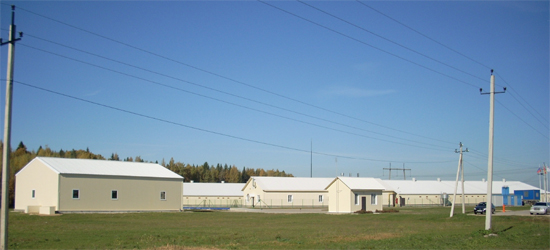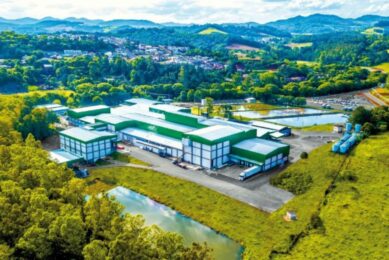African swine fever hampers Russian pork market

Although production performance of the pig industry in Russia showed a continuing positive trend in the first quarter of 2011, the growth rate of pork production has slowed down, according to a study by the analytical department of the Information Analytical Agency, ‘Imit’. Investments in the domestic Russian pig market lost attractiveness due to the more frequent outbreaks of African Swine Fever.
African Swine Fever (ASF) nowadays not only slows down the growth rate of pork production in Russia, but is also leading to its downfall in many other areas, such as in the Southern Federal District of Russia. The system of controlling the spread and prevention of epizootic diseases can be considered as a total failure. Since the first wave of outbreaks of the disease in 2009 the situation has not significantly changed, and currently a large number of pig farms in the country do not even meet basic veterinary requirements. ASF is not only a catastrophe for domestic pig production, but it also prevents the successful implementation of the goals and objectives of the National Food Security Doctrine, which remain essential, especially today in a period of unprecedented growth of global food prices.
Production increase slows down
According to the Federal State Statistics Service, by April 2011 the number of pigs of all categories in Russian farms was 17.928 million heads, which is 0.1% lower than for the same period of 2010. At the same time the number of pigs in agricultural organisations increased by 3.3% to 11.178 million; at peasant farms the number decreased by 3.4% to 776,000, and at private farms the number fell by 5.5% to 5.974 million.
Pork production in the first quarter of 2011 totalled to about 505,000 tonnes in carcass weight, which is 3.6% (17,700 tonnes) more than in the first quarter of 2010. The pace of industrial pork production (in agricultural organisations) in Russia in 2011 has slowed down. In 2009 and the first half of 2010 a significant amount of new pig breeding facilities went into operation. As a result the production by agricultural organisations at the end of 2010 increased by 18.3%. In the first quarter of 2010 compared with the same period of 2009 the total increase was 27.1%, or 56,700 tonnes in carcass weight.Pork production in agricultural organisations in the first quarter of 2011 compared to the same period of 2010 increased by 9.6% (25.500 tonnes) to 291.700 tonnes in carcass weight. The volume of pork production in agricultural organisations of Russia in March 2011 in total amounted to 108.900 tonnes in carcass weight, which is almost 16.5% more than in February this year and 7.7% more than in March of last year. In March 2010 there was an increase of production by 19.2% relative to February 2010, and 34.5% relative to March 2009.
Private farms
Pork production at private farms in the period of January-March 2011 fell 3.8% (7.500 tonnes) compared with the same period last year. In the medium term a slight fall in the annual pork production at private farms is expected which will approximately amount to 3-5% according to experts.
There are several reasons for this decline: rural population is aging and do not invest, which means a degradation of social complexes and economic infrastructure in rural areas of Russia. Also the younger working population is moving into the city, and furthermore the spread of ASF is holding back production.Pork production on the peasant farms in Russia is standing at a low level.
Nowadays in the country this form of husbandry is not widespread. The main share of farms is based on small forms of farming, and small-scale production on a commercial basis has low competitiveness in the country’s market. In the period of January-March 2011 the volume of pork production was up only by 13.300 tonnes, which is 0.2% less than during the same period of 2010.
Therefore, the transition of domestic pork production from the private and backyard systems into industrial holdings is continuing. The share of agricultural organisations (integrated operations) in total pork production in Russia in the first quarter of 2011 increased to 57.8% against 54.7% in the first quarter of 2010 and 47.4% in the first quarter of 2009.In the second quarter of 2011, there is a further reduction in production rates. Due to seasonality of breeding and slaughtering of pigs the second quarter is traditionally characterised by the lowest volume of pork production, which will be one of the main factors of price increases in that period.
Main areas
First place on the list of main pork producing areas in Russia is the Central Federal District (CDF). In the period of January-March 2011 total production of private and peasant farms in CDF amounted to 179,300 tonnes in carcass weight, which is 11.1% more than in the first quarter of 2010. The share of CFD in the first quarter of 2011 is 35.5% of the total pork production and 45.4% of the industrial production in the country.
The Volga Federal District (VFD) is the second major pork producing area, but production is stagnating – the overall increase was less than 1%, but at the same time an increase of production at the agricultural organisations in the district was 6.8%. The North-western Federal District (NFD) was the leader in terms of output growth which equalled to 11.6%. In the Southern Federal District (SFD) and the North Caucasus Federal District (NCFD) there has been a decline of total production by 7.9% and 11.3% respectively, and also a decline of industrial production of 4.5% and 15.1% respectively. Despite a significant drop in production figures, SFD continues to occupy a leading position in the production of pork per capita, due to the relative low number of inhabitants.According to a study of Intesco Research Group, the consumption of pork in Russia is consistently growing every year. In 2006 about 18 kg of pork was consumed per capita; in 2008 a Russian consuming 21 kg already ate 3 kg more, and in 2010 it increased further to 22 kg per capita.
Import
According to the data from ‘Imit’, in the first months of 2011 there has been an increase in the volume of pork imports from the USA, EU and Ukraine.
At the same time imports from Brazil – a leading exporter of pig meat to Russia – substantially declined. Export volumes of Brazilian pork to Russia in March 2011 amounted to 15,900 tonnes, which was 3.9% more than in February this year, but by 26.7% less than in March 2010. In the period of January-March 2011 from Brazil to Russia about 46,000 tonnes of pork were shipped, which is 15.4% lower than the same period of last year.In January-March of this year Russia imported 87.2% of the total Brazilian exports of pork. Previously, Russia and Ukraine were the leading consumers of Brazilian pork, but in the period of January-March this year, shipments of pork to the Ukraine were stalled (exports to Ukraine is carried out only in the form of cuts).
In the period of January-March of last year they accounted for almost 3,800 tonnes.Exports of pig carcasses to Russia in March 2011 amounted to slightly more than 3,000 tonnes, which is 3.3% less than in February 2011 and 31.5% less than in March of last year. In January-March 2011 approximately 9,500 tonnes of pig carcasses were shipped from Brazil to Russia, which was 14.5% more than in the same period of last year.The volume of exports of cuts from Brazil to Russia in March 2011 amounted to 12,900 tonnes, which is almost 5.8% more than in February 2011, but by 25.5% less than March 2010. In the period of January-March 2011 from Brazil to Russia 36,500 tonnes of cuts were shipped, which is 20.8% lower than in January-March 2010.Total exports of pork and pork products from the US to Russia in the period of January-February 2011 reached 7,279 tonnes, which is 15 times more than the same period of last year.
Prospects for the industry
According to the results of numerous studies it can be concluded that the plans of the Russian Ministry of Agriculture is feasible, and Russia will be able to significantly increase pork production up to 3.2 million tonnes by the deadline.
This aim was also presented in the draft federal target programme of pig production development up to 2015. The total volume of investments in the related projects amounted to more than 120 billion rubles (US$ 4.6 billion).
By 2012, the Russian pork market will be shaped under a growing influence of the Russian industry’s internal production growth, and a reduction in the volume of imports. As a result the share of domestic pork in the market will increase, which will lead to an intensification of competition between Russian producers and manufacturers of processed pork.
The trend of increased output along with reduced import supplies will remain in the Russian pork market until 2020, when the share of pork imports will be reduced to a minimum. Pushing back the (food) import volume is an important target of Russian policies. In 2008 imports covered 32.1% of consumption, in 2010 it already decreased to 25% and by 2020 the Russian government plans to fully overcome market dependence on imports.











